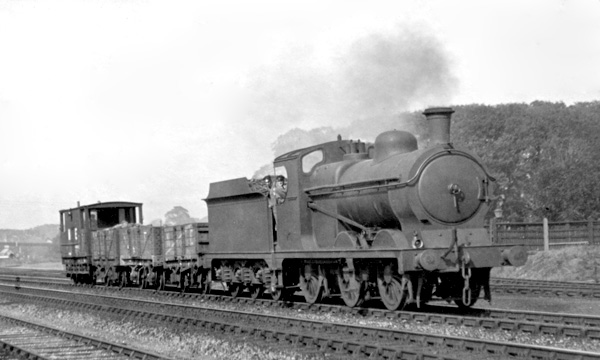GNR goods wagons
This is a collection of GNR wagons in pre-Grouping livery for an LNER-period layput in the 1920s when pre-Grouping liveries were common - they didn't disappear until the early-to-mid 1930s and enliven the scene beautifully. All are based on D&S kits, mostly whitemetal, one etched brass. The former will have been dispersed among other traders, possibly the brass one too, and their current whereabouts aren't known to me. I'll add the info as and when it comes to hand. All the pictures are my own.

A 6-plank open wagon to begin with, which, looking through Peter Tatlow's Vol.1, looks like a 19' wagon to GN.29 (as shown on p.25.) Built mostly with the parts provided although sprung buffers were made by drilling out the castings and fitting MJT parts. I added a through vacuum pipe, which you can see running under the wagon.
The brown finish, I was told long ago, wasn't red oxide but a red-biased shade of brown which, when weathered, who can tell? The upright for the vac pipe was painted red. It makes a nice change and can be run in fitted express goods, or at the head of a partly fitted one. Most of the transfers were PC Methfix, including the "N" for non-common user but the "GN" came from an old rub-on sheet from the GNRS. It's the right style but not as large as the company actually used.
Click on the image for an enlargement

This is a covered ventilated van of which I once scratch-built a batch of six, all slightly different, on the living room table. The D&S kit is based on the 19ft design shown in Tatlow-1 on pages 47-49 and the best comparison is with the lower picture on the third page. These books weren't available at the time and I'd have relied on the instructions and Peter's first issue about LNER Wagons. I sprung the buffers and tried to do the brake gear realistically (in which the push rod to the brakes was thicker than the pull rod) but got them upside down. There's a learning curve in making wagons like this and much better help out there nowadays so don't be afraid to go for it.
Click on the image for an enlargement

This is the other side with twin "V"-hangers, except that one is cast and the other etched (and under-size). Finish was as per the open wagon but with realistically larger "GN" letters. The text on the right hand side reads "To be returned to Colwick".
Click on the image for an enlargement

The GNR 8w goods brake van is a real sweetie. It got the same treatment as the other wagons plus some "help" around the lower steps where the legendary Dick Tarpey suggested joining up each pair with a piece of wire for strength. A great idea and almost invisible.
A near-white roof was required so I finished the model in muted colours. The edge of the roof should have the body colour: look at the ventilated van for the difference it makes. I always attach the roof last, after painting when this sort of thing is easy to do. Somewhere I have a picture of one of these vans in service and will include it later.
Click on the image for an enlargement

According to Peter Tatlow's book (see below), 60 of these brake vans were built, especially for heavy coal trains between Peterborough-London and Peter's book shows them in GNR, LNER and BR condition. Photographs in trains are rare and this view shows one that had wandered onto the GC Section, on the London Extension at the rear of a light through goods near Ruddington, midway between Nottingham and Loughborough. The date is unknown but appears to be sometime in the mid to late 1930s. It's mid-afternoon when there was a cluster of Class C coal trains between Annesley and Woodford, possibly the 2.45pm Annesley-Woodford which only ran when required. J11 No 5240 was allocated to Annesley at the time. Photo: Author's collection.

More can be seen in this enlargement, even a silhouette of the guard. Note the lamp high up on the side. Danny missed this on his kit, and at the time, so did I. It explains the steps and handrails along the body. I never thought to wonder why they were there before. For more details see Peter Tatlow's "LNER Wagons, Vol.1, LNER Southern Area" pp.95-97.
The other wagons are just as interesting:
1 : ex-NBR 8T 4-plank end door mineral wagon with grease axleboxes. Peter Tatlow described this one in his "LNER Wagons, Vol.3, Scottish Area" on pp.18-25. Note the primitive hand brake which operated a shoe on a single wheel each side (not cross-connected, of course). The livery includes a diagonal stripe to indicate which end was the opening one. 2 : ex-GCR 5-plank mineral wagon, exact type unclear. 3 : privately owned 5-plank mineral wagon whose owner's name cannot be read. There is a hint of "MOY" but as that merchant traded in Colchester, it's not a reliable guess.
In short, a complete train of pre-Grouping wagons with no sign here of the trusty 7-pl coal wagon, only 4- and 5-plank ones from preceding eras.

Finally there's the ballast brake van which I finished in earlier GNR livery with a red oxide roof for a collector. This is an etched brass kit and the birdcage is a bit of a tussle, but it is doable. There's a fabulous vintage feel to it, not just in the body shape and fittings but the red ends. It was early days for me photographically and I wasn't able to take a 3/4 view and maintain focus, but you can just see the red end stanchions and buffers.
Note how I painted the handrails the body colour, which I believe is correct. You don't notice, do you? The smaller lettering came from the PC Methfix LNER sheet.
Click on the image for an enlargement


